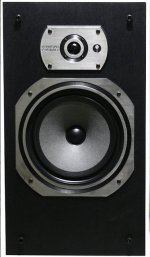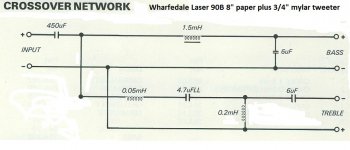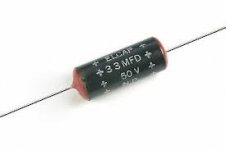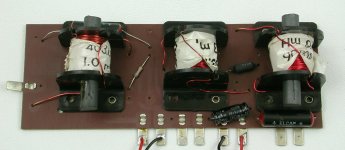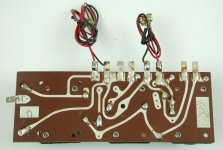system7: My apologies for the diversion.
I am really interested in hearing more about the Shelton crossover design. How important is the 1.5kHz notch filter in relation to this particular woofer?
Wonder how the system would sound with a lower order crossover arrangement?
There's so many ways to design a two-way of this type that I could write a very long essay. There are at least four distinct ways to do a bass filter with otherwise similar frequency responses.
The LCR trap operates at 1.3kHz to be precise. I'm not sure it's actually doing much notching. What it does do is nicely damp the bass filter to avoid peakiness. It also damps the bass voice coil a little more than usual, which I think makes for the smooth sound.
One for the repertoire of filter techniques. You can actually get to much the same place with the more modern simple LC filter (which often needs a little shunt resistance R), used in the similar later Wharfedale Laser 90B. FWIW, the tweeter filter used there is much more like the famous old Celestion one. The tweeter was a particularly competent design which an ex-engineer here told us about a while back.
Maybe that Laser 90B is "The all too often seen filter" that Troels Gravesen has been known to rant about. It tends to bassiness and an edgy sound in the midrange in my experience. It's difficult to get everything right with only two variables to play with. The Shelton has more wiggle room.
Attachments
Last edited:
Thanks for your explanation Steve - the 'LCR trap' is therefore a 'contour network' which shapes the bass/midrange driver's response curve.
I have no experience of the Sheltons but I would describe the sound of the Lintons that I owned in the seventies as 'shut in'. I always wondered if this was down to the crossovers or to the drivers themselves.
I recently acquired a pair of Dentons. The drivers were in good working order so I went ahead and replaced the crossover capacitors. I was disappointed that this did not improve the rather dull and unexciting sound the Dentons produced.
Your work on the Sheltons has inspired me to have another look at the Dentons. I fancy trying them out with a simple first order network to see if that opens out the sound and helps them 'sing'. Rest assured that I don't seek accuracy from such budget speakers!
I may post details of the original Denton crossover circuit as I would value your analysis.
I have no experience of the Sheltons but I would describe the sound of the Lintons that I owned in the seventies as 'shut in'. I always wondered if this was down to the crossovers or to the drivers themselves.
I recently acquired a pair of Dentons. The drivers were in good working order so I went ahead and replaced the crossover capacitors. I was disappointed that this did not improve the rather dull and unexciting sound the Dentons produced.
Your work on the Sheltons has inspired me to have another look at the Dentons. I fancy trying them out with a simple first order network to see if that opens out the sound and helps them 'sing'. Rest assured that I don't seek accuracy from such budget speakers!
I may post details of the original Denton crossover circuit as I would value your analysis.
Could anyone kindly advise on what replacement speakers to use in my Shelton XP2s, and a suitable UK supplier?
I sourced mine from a skip so they don't owe me anything. Not one of the bass or tweeters work, so I basically have empty cabinets. These do seem to turn up for sale in working order occasionally around 50 quid so that is probably the benchmark budget, unless replacements would be an improvement over originals.
Many thanks and apols for piggy backing on this thread!
I sourced mine from a skip so they don't owe me anything. Not one of the bass or tweeters work, so I basically have empty cabinets. These do seem to turn up for sale in working order occasionally around 50 quid so that is probably the benchmark budget, unless replacements would be an improvement over originals.
Many thanks and apols for piggy backing on this thread!
Last edited by a moderator:
Seems a bit unlikely that EVERYTHING has blown up. 
Is your Amp and source working?
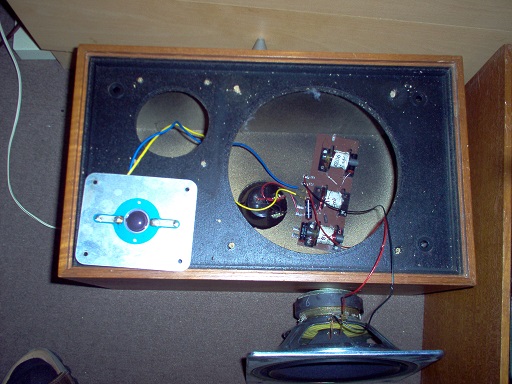
Basic idea is to find some new drivers that fit on measurement:
Wilmslow Units
But really you need an electrical multimeter and a bit of testing at this stage. Even a 1.5V battery can be substituted to establish basic connectivity and function.
Is your Amp and source working?
Basic idea is to find some new drivers that fit on measurement:
Wilmslow Units
But really you need an electrical multimeter and a bit of testing at this stage. Even a 1.5V battery can be substituted to establish basic connectivity and function.
If those Sheltons happen to have been stored for years in a damp garage, I wouldn't be surprised if voice coil rot has affected the drivers.Seems a bit unlikely that EVERYTHING has blown up.
This has certainly happened to a couple of pairs of Wharfedale tweeters which I foolishly abandoned to the humidity and temperature extremes of the Scottish climate!
As Steve suggests, disconnect the woofers and tweeters from the crossover network and test them by connecting a 1.5V battery momentarily across their terminals. If the drivers still have life in them, you should hear a crackling sound.
If the drivers have gone to see their maker, post the diameter of the woofer and tweeter mounting holes in the enclosure. This will at least help narrow the choice of substitute drivers to ones which physically fit.
I saw a pair of Wharfedale Dentons at auction the other night. The tweeters and woofers had been replaced by neat looking alternatives, the baffles painted black and the teak veneered enclosures given a waxing. They looked great! However, the woofer was a very cheap, PA replacement so goodness knows how they sound!
EDIT: Reading back, I see Steve gave mounting hole dimensions earlier in the thread.
Last edited:
Thanks for these replies.
The bass drivers show 4ohms on a multimeter - but when I connect them directly to the speaker amp output they are both very crackly. I assume these need replacing. They have a 183mm diameter hole - so the Wilmslow 206 diameter driver might fit WA - 206 Bass-mid Diameter 206mm
Neither tweeter has any sign of life so looking for replacements to the 80 mm diameter hole. These would slot in Monacor DT-100 Size 116x80mm
Would these above work together?
Is there any simple way to test the cross over before I commit? I have a multimeter, and can solder in replacement capacitors, but failed the electronics module of my engineering degree (a long time ago).
rgds.
The bass drivers show 4ohms on a multimeter - but when I connect them directly to the speaker amp output they are both very crackly. I assume these need replacing. They have a 183mm diameter hole - so the Wilmslow 206 diameter driver might fit WA - 206 Bass-mid Diameter 206mm
Neither tweeter has any sign of life so looking for replacements to the 80 mm diameter hole. These would slot in Monacor DT-100 Size 116x80mm
Would these above work together?
Is there any simple way to test the cross over before I commit? I have a multimeter, and can solder in replacement capacitors, but failed the electronics module of my engineering degree (a long time ago).
rgds.
Last edited by a moderator:
I was at a loose end, so decided to browse for possible replacement drivers - with the emphasis being on not spending too much cash! 
cpc do several replacement 8" woofers, some of which don't break the bank!
This 'general purpose' 8" woofer is a possibility. The T/S parameters are given in its data sheet if Steve wants to get technical:
https://cpc.farnell.com/unbranded/55-1195/woofer-polyprop-cone-8ohm-8/dp/LS00430
http://www.farnell.com/datasheets/2865696.pdf
cpc also do an inexpensive dome tweeter which will fit if you enlarge the mounting hole slightly with a rounded file:
https://cpc.farnell.com/visaton/sc10n/speaker-soft-dome-tweeter-1/dp/LS02156
http://www.farnell.com/datasheets/2623814.pdf
cpc do several replacement 8" woofers, some of which don't break the bank!
This 'general purpose' 8" woofer is a possibility. The T/S parameters are given in its data sheet if Steve wants to get technical:
https://cpc.farnell.com/unbranded/55-1195/woofer-polyprop-cone-8ohm-8/dp/LS00430
http://www.farnell.com/datasheets/2865696.pdf
cpc also do an inexpensive dome tweeter which will fit if you enlarge the mounting hole slightly with a rounded file:
https://cpc.farnell.com/visaton/sc10n/speaker-soft-dome-tweeter-1/dp/LS02156
http://www.farnell.com/datasheets/2623814.pdf
Last edited:
The Wilmslow woofer looks a good bet, but the tweeter is not a good physical fit.
I'd go for a round tweeter such as: Monacor DT-107 Diameter 97mm which also has the advantage of matching the woofer in sensitivity (loudness).
Details re crossover to follow!
I'd go for a round tweeter such as: Monacor DT-107 Diameter 97mm which also has the advantage of matching the woofer in sensitivity (loudness).
Details re crossover to follow!
Really, a new crossover design is needed to suit the new drivers, but it won't cost much to renovate the Shelton crossovers and give them a try for starters.
The black/red ELCAP capacitors in the crossover should be replaced by modern bipolar electrolytic capacitors - also available from Wilmslow:
Mundorf Electrolytic ECap Capacitors
The other crossover components should be just fine.
The simplest way to test the renovated crossover is to connect it to the new drivers.
The black/red ELCAP capacitors in the crossover should be replaced by modern bipolar electrolytic capacitors - also available from Wilmslow:
Mundorf Electrolytic ECap Capacitors
The other crossover components should be just fine.
The simplest way to test the renovated crossover is to connect it to the new drivers.
Attachments
P.S. I've checked the specs of the cpc woofer.
https://cpc.farnell.com/unbranded/55-1195/woofer-polyprop-cone-8ohm-8/dp/LS00430
With a Qts of 0.58 and an EBP of 49, it is suitable for a sealed enclosure.
https://cpc.farnell.com/unbranded/55-1195/woofer-polyprop-cone-8ohm-8/dp/LS00430
With a Qts of 0.58 and an EBP of 49, it is suitable for a sealed enclosure.
Galu and Steve -
Thanks so much. That's amazing advice and EXACTLY what I needed to know. You have both earned an invite to an afternoon in my living room listening to Tangerine Dream's longest hits.
A choice of 169 or 75 plus delivery for 2 pairs of drivers and replacement caps - and an assumption you get what you pay for.
Will be back in touch once I have made my choice and have things wired up and checked out the crossover. And about those Mission 70s I have...
Ric
Thanks so much. That's amazing advice and EXACTLY what I needed to know. You have both earned an invite to an afternoon in my living room listening to Tangerine Dream's longest hits.
A choice of 169 or 75 plus delivery for 2 pairs of drivers and replacement caps - and an assumption you get what you pay for.
Will be back in touch once I have made my choice and have things wired up and checked out the crossover. And about those Mission 70s I have...
Ric
Last edited by a moderator:
I'm a bit surprised the woofers have failed. Might be worth testing them direct to the amplifier with no crossover.
When a tweeter blows, the impedance of the crossover goes very resonant and maybe causing the crackle.
Old woofers sometimes sag and rub voicecoil. You can feel it if you press the cone in. The cure is often to just turn them 90 degrees.
Just a long shot...
Good luck with this and tell us how you get on.
I would order a few 5W resistors too. say, 2.2R and 4.7R and 10R. Will allow you to tweak tweeter level if necessary.
When a tweeter blows, the impedance of the crossover goes very resonant and maybe causing the crackle.
Old woofers sometimes sag and rub voicecoil. You can feel it if you press the cone in. The cure is often to just turn them 90 degrees.
Just a long shot...
Good luck with this and tell us how you get on.
I would order a few 5W resistors too. say, 2.2R and 4.7R and 10R. Will allow you to tweak tweeter level if necessary.
Last edited:
Ric has tested the woofers by direct connection to the amplifier.
Steve, do you happen to have a schematic of the original Shelton XP2 crossover (not your modified version)? I see a couple of resistors in there.
I've attached clear photos of both the component and track sides of the crossover board. I see that one of the capacitors and one of the resistors has been changed on this one, but the crossover is complete.
The crossover frequency is said to be 3.5kHz.
Steve, do you happen to have a schematic of the original Shelton XP2 crossover (not your modified version)? I see a couple of resistors in there.
I've attached clear photos of both the component and track sides of the crossover board. I see that one of the capacitors and one of the resistors has been changed on this one, but the crossover is complete.
The crossover frequency is said to be 3.5kHz.
Attachments
I worked with this schematic:
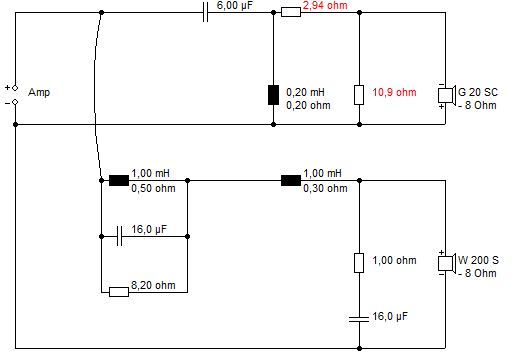
The tweeter attenuator was a modelling device I used to adjust level in my sim. The 1R resistor was to allow for the NPE capacitor, since it seemed to make a lot of difference.
I never decided what the metal oxide resistor did, but it was around 500 ohms, so probably not much.
The tweeter attenuator was a modelling device I used to adjust level in my sim. The 1R resistor was to allow for the NPE capacitor, since it seemed to make a lot of difference.
I never decided what the metal oxide resistor did, but it was around 500 ohms, so probably not much.
Success! New speakers and caps fitted and a stream of Philip Glass and Ali Farka Toure came through.
Wilmslow were out of stock of the suggested drivers so I opted for Monacor SPM-205/8 Size 200x200mm
I have to drive them noticeably harder than my previous speakers (Mission 70s) - they seem to need considerably more power.
Could I ask, then, what do I do with the extra resistors you suggested I arm myself with? The original resistors are still in place. Tx in advance.
Wilmslow were out of stock of the suggested drivers so I opted for Monacor SPM-205/8 Size 200x200mm
I have to drive them noticeably harder than my previous speakers (Mission 70s) - they seem to need considerably more power.
Could I ask, then, what do I do with the extra resistors you suggested I arm myself with? The original resistors are still in place. Tx in advance.
Last edited by a moderator:
I recently bought a rather rough looking pair of Sheltons for playing with - this thread inspired me as it has details of the crossover - sadly neither tweeter was much good - worked (just) so decided to fit a pair of Monacor DN-24's an excellent little tweeter and inexpensive. The Monacor has an spl of 96db so Lpads were fitted - once again from Monacor.
I replaced the caps on the xover and checked the resistors and was surprised to find the 1R in the filter on the bass driver is actually 12 Ohms ( same on both boards) thought that may be of interest if you have Sheltons.
After listening for a few days I decided to change the Xover to an 18db (tweeter) and 6db (bass) arrangement - this produced remarkably better results - I did fit the 12R - 16uf filter to the bass unit as per the original Cover.
I replaced the caps on the xover and checked the resistors and was surprised to find the 1R in the filter on the bass driver is actually 12 Ohms ( same on both boards) thought that may be of interest if you have Sheltons.
After listening for a few days I decided to change the Xover to an 18db (tweeter) and 6db (bass) arrangement - this produced remarkably better results - I did fit the 12R - 16uf filter to the bass unit as per the original Cover.
- Home
- Loudspeakers
- Multi-Way
- Wharfedale Shelton XP2, A minor classic IMO
